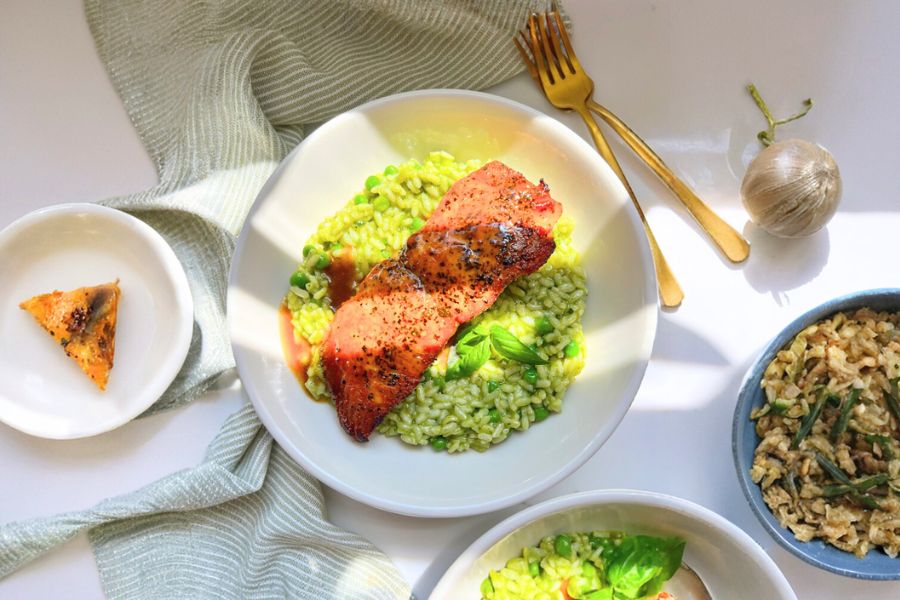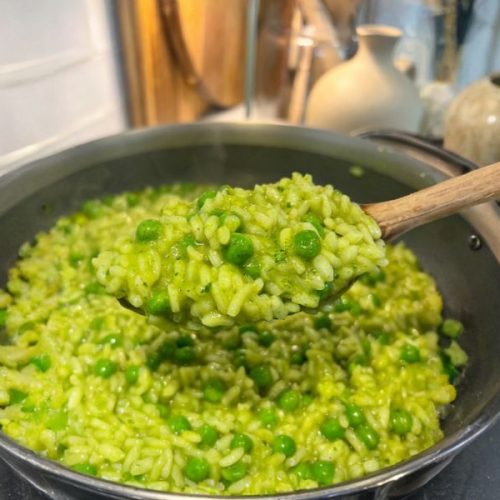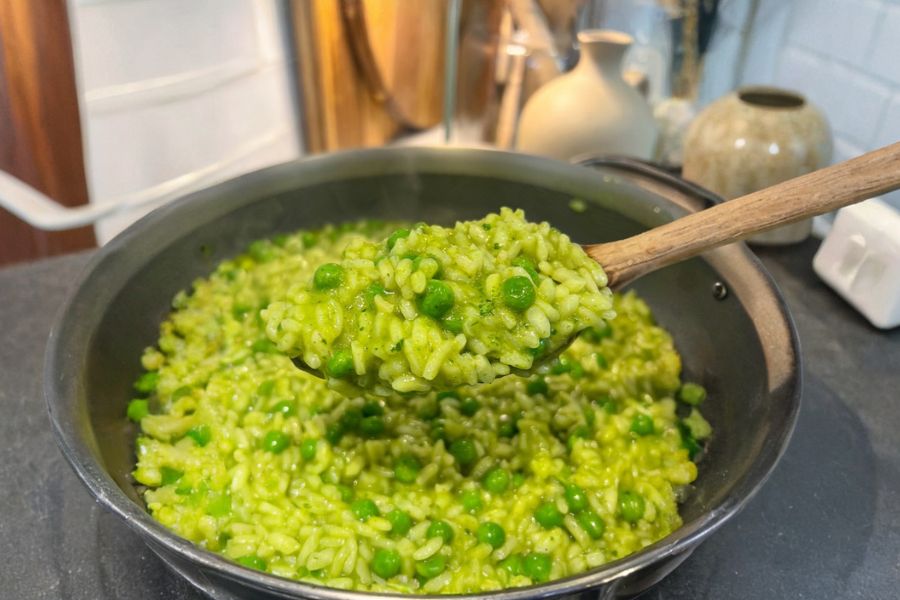This Maple-Dijon Glazed Crispy Salmon with Pesto Risotto offers a delicious balance of bold flavors and wholesome nutrition, making it a standout dish for any day of the week.
The salmon provides a rich source of high-quality protein and heart-healthy omega-3 fatty acids, which support brain and cardiovascular health.
Paired with creamy risotto infused with vibrant basil pesto and fiber-rich peas, this meal delivers a satisfying dose of plant-based nutrients and antioxidants.
The recipe’s moderate prep and cook times make it accessible for busy cooks, while its elegant presentation adds a touch of sophistication to your dinner table.

Whether you’re looking for a nourishing family meal or a flavorful way to impress guests, this dish combines ease, nutrition, and gourmet flair effortlessly.
Must-Have Tools for Perfect Results
Oven-Safe Skillet
Ideal for searing the salmon and finishing it in the oven, this versatile pan ensures even cooking and beautiful caramelization. Its durability makes it a kitchen staple for everything from sautéing to roasting.
Large Skillet or Sauté Pan
Perfect for preparing the creamy pesto risotto, this pan allows for even heat distribution and easy stirring, helping you achieve the perfect tender texture every time.
Measuring Cups and Spoons
Essential for accurately measuring ingredients like rice, liquids, and seasonings, these tools guarantee consistent results and help maintain the recipe’s flavor balance.
Wooden Spoon or Silicone Spatula
Gentle on cookware and perfect for stirring risotto, these utensils allow for smooth incorporation of ingredients without scratching pans.

30-Minutes Maple Dijon Glazed Salmon
Equipment
- 1 Oven-safe skillet
- 1 Large skillet or sauté pan
- Measuring cups and spoons
- Wooden Spoon or Silicone Spatula
Ingredients
For the Pesto Risotto:
- 2 tbsp Unsalted Butter
- 4 cups Vegetable or Chicken Stock
- 1/4 cup Dry White Wine
- 1 cup Arborio Rice
- 1/2 cup Basil Pesto homemade or store-bought
- 1/3 cup Grated Mozzarella optional
- 1 cup Frozen Peas optional
For the Maple-Dijon Glazed Salmon:
- 2-4 Salmon Fillets depending on thickness
- 2 tbsp Olive Oil
- 1/3 cup Maple Syrup
- 1 tbsp Dijon Mustard
- 2 tbsp Water
- 2 tbsp Melted Butter
Instructions
- Sauté the Arborio Rice: In a large skillet over medium-high heat, melt the unsalted butter until it’s shimmering but not browned. Add the Arborio rice and stir continuously for 2 to 3 minutes, allowing the rice to toast lightly and absorb the butter, which enhances its nutty flavor and prepares it for slow cooking.
- Deglaze with White Wine: Pour in the dry white wine to deglaze the skillet, scraping any bits off the bottom with a wooden spoon or spatula. Continue stirring the rice until the wine is fully absorbed, which helps deepen the flavor of the risotto base.
- Gradually Add Stock and Stir: Begin adding the vegetable or chicken stock one cup at a time, stirring frequently to encourage the rice to release its creamy starches. Wait until each addition is almost completely absorbed before adding the next, repeating this process over 18 to 22 minutes until the rice is tender but still has a slight bite.
- Incorporate Pesto, Peas, and Cheese: When adding the final cup of stock, mix in the basil pesto, frozen peas, and optional grated mozzarella. Stir gently and reduce heat to low, letting the risotto simmer until it reaches a creamy, slightly thick consistency. Add a splash of heavy cream if needed to adjust the texture to your liking.
- Preheat and Prepare for Salmon Searing: While the risotto cooks, preheat your oven to 400°F (200°C). Heat olive oil in an oven-safe skillet over medium-high heat until hot but not smoking, which ensures a crispy sear on the salmon.
- Season and Sear the Salmon: Pat the salmon fillets dry, then season generously with salt and black pepper on both sides. Place them skin-side down (if applicable) in the skillet, searing each side for about 2 to 3 minutes until golden brown and crispy.
- Finish Cooking Salmon in the Oven: Carefully transfer the skillet with the seared salmon into the preheated oven. Bake for 8 to 10 minutes, depending on the thickness of your fillets, until the salmon flakes easily with a fork and is cooked through but still moist.
- Prepare the Maple-Dijon Glaze: While salmon cooks, whisk together maple syrup, Dijon mustard, water, and melted butter in a small saucepan. Heat over medium heat, stirring occasionally, until the glaze thickens slightly, about 4 to 5 minutes, taking care not to let it burn.
- Serve and Glaze the Salmon: Remove the salmon from the oven and transfer to serving plates. Spoon the warm maple-Dijon glaze generously over the fillets, then serve alongside the creamy pesto risotto for a balanced, flavorful meal.
Notes
- Use homemade basil pesto for a fresher, more vibrant flavor, or choose a high-quality store-bought version for convenience.
- If you prefer a richer risotto, stir in a little heavy cream or extra butter at the end to reach your desired creaminess.
- Be careful not to overcook the salmon to keep it moist and flaky; use a meat thermometer if available (130°F-135°F is ideal).
- Frozen peas add color and fiber, but feel free to substitute with fresh peas or skip if preferred.
- This dish pairs beautifully with a light green salad or steamed vegetables for a complete meal.
Chef’s Secrets for Perfect Flavor
Achieving a perfectly balanced Maple-Dijon Glazed Salmon with Pesto Risotto comes down to layering flavors and mastering timing.
Toasting the Arborio rice before adding liquids unlocks its nutty aroma and ensures a creamy texture without becoming mushy.
When deglazing with white wine, patience is key—let it fully absorb to add depth to the risotto.
For the salmon, drying the fillets thoroughly before seasoning helps create that sought-after crispy crust during searing.
Using an oven-safe skillet means you can transition seamlessly from stovetop to oven, preserving the salmon’s moisture.
The maple-Dijon glaze should be gently simmered until it thickens slightly—avoid boiling vigorously to prevent bitterness.
Lastly, incorporating fresh basil pesto enhances the risotto’s brightness and balances the richness of the salmon, making this dish harmonious and elegant.
Serving Suggestions to Elevate Meal
This dish shines when paired with simple, fresh sides that complement its richness.
A crisp mixed greens salad dressed lightly with lemon vinaigrette adds refreshing acidity and crunch, cutting through the creamy risotto and sweet glaze.
Roasted or steamed seasonal vegetables like asparagus, green beans, or baby carrots provide color and fiber, rounding out the meal nutritionally.
For a heartier option, serve alongside crusty garlic bread or a rustic baguette to soak up any extra glaze or risotto sauce.
Consider a light white wine such as Pinot Grigio or Sauvignon Blanc to enhance the herbal notes of the pesto while complementing the salmon’s buttery texture.
Storage Tips to Maintain Freshness
To keep leftovers fresh, store the salmon and risotto separately in airtight containers in the refrigerator.
The risotto will keep well for up to 3 days but may thicken as it cools; reheat gently over low heat with a splash of broth or cream to restore its creamy consistency.
Salmon is best enjoyed within 1-2 days for optimal flavor and texture.
Avoid freezing the risotto as it can affect the texture negatively.
for the glaze, store in a small container and reheat briefly to drizzle over reheated salmon.
When reheating salmon, use a low oven temperature or microwave on a lower setting to avoid drying it out.
Frequently Asked Questions Answered Clearly
Q1: Can I use a different fish instead of salmon?
Absolutely! This glaze works well with other fatty fish like trout or arctic char, and even with firm white fish such as cod. Just adjust cooking times based on thickness.
Q2: Is the risotto vegetarian?
Yes, if you use vegetable stock and omit the optional mozzarella, the risotto is vegetarian-friendly. Using chicken stock will add extra richness but is not suitable for vegetarians.
Q3: Can I make the pesto risotto ahead of time?
You can prepare the risotto a day in advance, but it’s best reheated gently with some liquid added. Fresh pesto can be stirred in after reheating for brightness.
Q4: How do I know when the salmon is done?
Salmon is cooked when it flakes easily with a fork and reaches an internal temperature of 130°F to 135°F for medium doneness. Cooking times vary with thickness.
Q5: Can I substitute the maple syrup?
Yes, you can substitute honey or agave syrup if preferred, though the flavor will vary slightly. Avoid using refined sugar or corn syrup for best taste and glaze consistency.
This recipe has been adapted and simplified from the original version by abrightmoment. We’ve refined the steps for a smoother cooking experience and added helpful notes, nutrition insights, and essential kitchen tools to make it even easier for home cooks.

